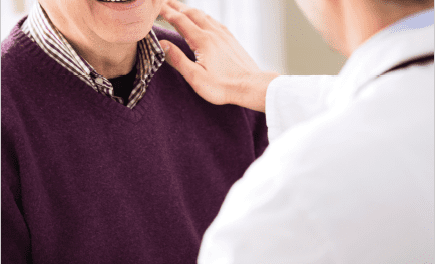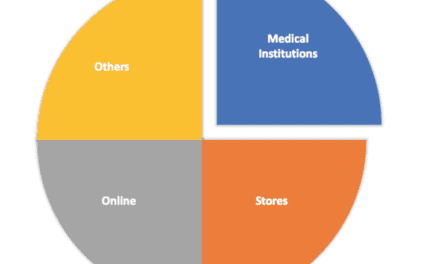This is the first of three articles that will review migraine and its relationship to a variety of audiovestibular symptoms and conditions. This first article provides an overview of the disorder of migraine, and includes the description and classification of migraine with a review of its prevalent audiovestibular symptoms and management.
The second article will focus on mal de debarquement, better known as disembarkment sickness. This is the sensation that one is rocking, rolling, or swaying after return to land. Patients with mal de debarquement can present with a more chronic and debilitating condition, with the symptoms lasting for weeks, months, or even years. The literature and clinical experience suggest that it is seen almost exclusively in a population with a history of motion intolerance and migraine.1
The final article will discuss a pediatric migraine variant called benign paroxysmal vertigo (BPV) of infancy. This condition is seen in infants and young children from ages 1-4 years old. They experience very brief episodes of vertigo, sometimes lasting only a few minutes. In some cases, it is also accompanied by a self-limiting condition called torticollis, which results in a head tilt. Although these children usually grow out of the condition by age 5-6, there may be a higher prevalence of migraine and Meniere’s disease in their adolescence and in later life.2
When most people hear the term migraine, they associate it with an acute or debilitating headache. Many patients with migraine, however, suffer a variety of audiovestibular-like symptoms that may either accompany or precede a headache. In some patients, as we will discuss further, there may only be a variety of symptoms in the absence of any headache pain.
Description and Classification of Migraine
Most individuals have heard the term migraine; however, even experts have some difficulty with a specific definition. There is such variability across migraine patients that providing an all-inclusive definition of the condition can be quite challenging. Prior to the Headache Classification Committee of the International Headache Society (IHS) publication3 in 1988, there were a variety of definitions provided by the National Institute of Neurological Diseases and Blindness,4 as well as the World Federation of Neurology,5 which offered similar but slightly conflicting definitions.
The IHS defines migraine according to specific characteristics, including recurrence of attacks; limited duration of each attack (from 4-72 hours); pain that has a unilateral location, a pulsating quality, and intensity sufficient to disrupt daily activities; and a sensitivity to retain physical activities; and in association with nausea, vomiting, photophobia, and phonophobia. The Headache Classification Committee also went on to classify migraine in seven subgroups, and a miscellaneous eighth category, as can be seen in Table 1. Within these seven primary categories, there are many additional differentiations.
|
Table 1. Classification of Migraine |
|
|
|
| Source: Headache Classification Committee of the International Headache Society (www.i-h-s.org). |
The vast majority of migraine variants are made up of migraine without aura and migraine with aura. The term aura can be defined as a focal neurological disorder. Auras are generally considered abnormal sensory perceptions. Visual auras are the most frequent type, and may come in a wide variety of phenomena or hallucinations. Table 2 provides a listing of symptoms, that may be experienced by migraine patients.6
|
Table 2. Symptoms That May Be Experienced by Migraine Patients |
|||
|
Prevalence
It is estimated that, in the United States and Europe, 50% of women and 40% of men experience at least one severe, debilitating headache at some time during their lives. Following the HIS criteria, it has been reported that 15%-18% of women, and 6%-7% of men probably experienced some form of migraine disorder.7,8 This gender effect suggests a 3-to-1 female to male gender ratio. Women often show onset of the condition during puberty that dissipates as they approach menopause.
Migraine research indicates that a strong familial link exists, suggesting both mitochondrial DNA and chromosomal inheritance with a variety of familial types of migraine.9,10 There is also an increased incidence of reported migraines, from 35% reported in the 1960s to 50% in the 1990s. However, this increase may be due to an elevated awareness and interest in the management of migraine patients.
Pathophysiology
Numerous theories exist on the underlying pathophysiology of migraine in its many variations. One theory implies a vascular condition may cause a vasodilatation of extracranial vessels, which cause the headaches. There is some further speculation that the vasospasm of the intracranial vessels produces the other symptoms and auras.11
There is also the theory, however, that it is the metabolic defect slowly spreading across the cerebral cortex, which is referred to as a spreading wave of depression responsible for, in particular, visual auras.11 These vasospasms may occur in the peripheral sensory organs, such as the eye, or the inner ear, or may occur within the brainstem.
The ion channel disorder theory would also address the issues of genetic and familial inherited migraine syndromes. This categorization would account for two forms of inherited migraine: familial hemiplegic migraine (FHM) and episodic ataxic migraine (EA2). The defective calcium channel phenomenon would explain the increased extracellular potassium that initiates the spreading wave of depression in migraine. As the relationship between calcium and potassium is critical in maintaining the potassium-rich endolymph within the inner ear, for example, the problem in the ion channel in either the brain or ear could lead to dysfunction of the sensory mechanisms.
There continues to be much controversy and speculation over the pathophysiology of migraine, and readers are encouraged to review the literature for a more thorough discussion of the various theories.
Audiovestibular Symptoms Associated with Migraine
It is valuable for hearing care professionals to have at least a basic understanding of migraine and audiovestibular symptoms. Vertigo, tinnitus, photophobia, and phonophobia, and occasionally hearing loss may present in at least 30% of migraine patients.12 Although hearing loss in migraine patients is less common than in vertigo, tinnitus, photophobia, and phonophobia, it may present as a low frequency fluctuating sensorineural hearing loss.13 It is possible, however, to have a permanent hearing loss or vestibulopathy (as indicated by caloric weakness) secondary to a migraine attack.14 The commonality of these symptoms often make it difficult to distinguish the disorders on clinical grounds alone.
This collection of symptoms may first be thought as consistent with Meniere’s disease, or other types of inner ear involvement (eg, recurrent vestibular neuronitis), particularly in patients with recurring episodes or attacks. The differential diagnosis of migraine and Meniere’s disease, therefore, may often present as a diagnostic enigma.15 Interestingly, the incidence of Meniere’s disease is twice as prevalent in migraineurs, as in the general population.16 In addition, 60% will report a lifelong history of motion sensitivity.
The diagnostic challenge is further complicated if a differential diagnosis of multiple sclerosis (MS) is included. The initial onset of acute, debilitating vertigo will appear as the initial symptom in 5% of MS patients. As many as 50% of MS patients will experience at least one occurrence of acute vertigo at some time during the course of the disease.17 This may also be compounded by the fact that one in 10 MS patients will present with hearing loss, which may be partial or complete, but the patient often recovers—similar to the migraine or Meniere’s patient.
Management
Hearing care professionals can provide the patient with an important first step toward management by identifying the audiovestibular symptoms of the migraine patient. Oftentimes, migraineurs may not themselves associate their symptoms with migraine.
Appropriate referral to a physician will be an integral part of the continuum of care for this patient. Historically, neurologists have taken a lead role in the management of the migraine patient. It is possible, however, for interested primary care and internal medicine physicians to also play a role in the management of their migraine patients. Migraineurs may be managed pharmacologically through drugs to manage either the vascular or the calcium channel form of migraine. This may take several trials of pharmacological agents, as the physician and patient work together to try to identify those pharmaceuticals that provide the best results.
Many migraineurs will have triggers that will precipitate or aggravate their condition. Table 3 is a list of common triggers associated with migraine. Therefore, patients and their physician together may wish to explore those lifestyle habits, foods, and beverages that may be contributing factors to the exacerbation of their symptoms. Tusa,18 for example, has recommended a weekly workout regimen and increased physical activity prior to bedtime for stress reduction in migraine patients with quite successful results.
|
Table 3. Common Triggers Associated with Migraine |
|
|
Vestibular rehabilitation therapy (VRT) has shown to be an efficacious treatment for those migraine patients that suffer a permanent and uncompensated unilateral vestibular dysfunction (UVD).19,20 For patients who present with vestibulopathy with chronic symptoms—such as oscillopsia with head movement, exaggeration of motion, and increased motion intolerance—VRT will successfully ameliorate their symptoms through the use of adaptation and habituation techniques, just as it does for virtually all patients with vestibulopathy secondary to conditions such as vestibular neuritis, labyrinthitis, or labyrinthine ischemia.19,20 It is important to remember, however, that VRT will not treat the migraine itself. It will, however, address the uncompensated vestibulopathy secondary to the migraine.
Summary
The purpose of this overview is to provide the reader with an appreciation of migraine and associated audiovestibular symptoms that patients may be presenting to hearing care professionals. Through a better understanding of the prevalence and audiovestibular symptoms of the condition, hearing care professionals can assist these patients with an appropriate referral to a medical specialist best qualified to treat and manage this chronic and debilitating condition.
|
|
Richard E. Gans, PhD, is founder and executive director of the American Institute of Balance, Seminole, Fla, and author of the books Vestibular Rehabilitation: Protocols and Programs, and The ENG Handbook. |
Correspondence can be addressed to HR or Richard E. Gans, PhD, American Institute of Balance, 11290 Park Blvd, Seminole, FL 33772; email: [email protected].
References
1. Hain TC, Hanna PA, Rheinberger MA. Mallevollort de Debarquement. Arch Otolaryngol Head and Neck Surgery. 1999;125:615-620.
2. Deonna TW, Martin D. Paroxysmal disorders which may be migraine or confused with it. In: Hockday JM, ed. Migraine in Childhood. London: Butterworth; 1988:75-87.
3. Headache Classification Committee of the International Headache Society. Classification and diagnostic criteria for headache disorders, cranial neuralgias, and facial pain. Cephalagia. 1988;8:1-96.
4. Ad Hoc Committee on Classification of Headache. Classification of Headache. JAMA. 1962;179:717-718.
5. World Federation of Neurology. Definition of Migraine. In: Cochrane AI, ed. Background to Migraine, Third Migraine Symposium. London: Heinemann; 1970: 181-182.
6. Davidoff RA. Migraine: Manifestations, Pathogenesis, and Management. 2nd ed. New York: Oxford Press; 2002:44-67.
7. Rasmussen BK, Jensen R, Schroll M, Olesen J. Epidemiology of headache in a general population—a prevalence study. J Clin Epidemiol. 1991;44:1147-1157.
8. Rasmussen BK, Olesen J. Migraine with aura and migraine without aura: an epidemiological study. Cephalagia. 1992; 12:221-228.
9. Haan J, Terwindt GM, Maassen JA. Search for mitochondrial DNA mutations in migraine subjects. Cephalagia. 1999; 19:20-22.
10. Ducros A, Joutel A, Vahedi K. Later news about chromosome I Familial hemiplegic migraine locus. Frontiers in Headache Research. 2000;8:251-255.
11. Baloh RW. Neurotology of migraine. Am Headache Soc. 1997;37(10):615-621.
12. Baloh RW, Honrobia V. Clinical Neurophysiology of the Vestibular System. 3rd ed. New York: Oxford Press; 2001:264-276.
13. Lee H, Lopez I, Ishiyama A, Baloh RW. Can migraine damage the inner ear? Arch Neurol. 2000;57:1631-1634.
14. Viire ES, Baloh RW. Migraine as a cause of sudden hearing loss. Amer Headache Soc. 1996;36(1):24-8.
15. Dimitri PS, Wall C, Oas JG, Rauch SD. Application of multivariate statistics to vestibular testing: discrimination between Meniere’s disease and migraine associated dizziness. J Vestibular Res. 2000;11:53-65.
16. Parker W. Meniere’s disease: etiologic considerations. Arch Otolaryngol Head and Neck Surgery. 1995;12:377-382.
17. Leigh J. The Neurology of Eye Movements. 3rd ed. New York: Oxford University Press; 1999:405-616.
18. Tusa RJ. Diagnosis and management of neuro-otological disorders due to migraine. In: Herdman SJ, ed. Vestibular Rehabilitation. 2nd ed. Philadelphia: FA Davis; 2000:298-315.
19. Wrisley DM, Whitney SL, Furman JM. Vestibular rehabilitation outcomes in patients with a history of migraine. Otology & Neurology. 2002;23:483-487.
20. Whitney SL, Wrisley DM, Brown KE, Furman JM. Physical therapy for migraine-related vestibulopathy and vestibular dysfunction with history of migraine. Laryngoscope. 2000;110:1528-1534.





